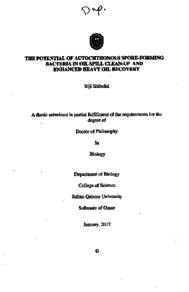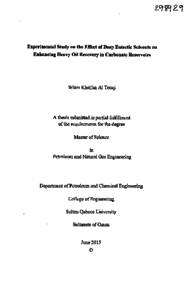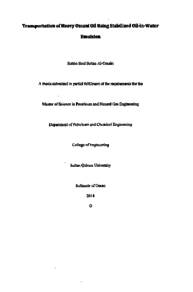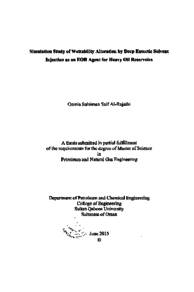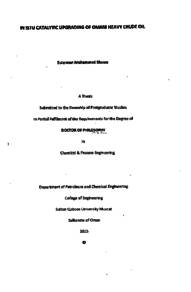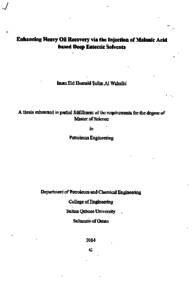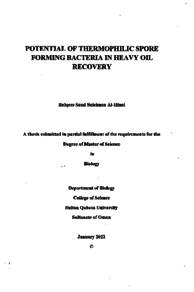Document
The potential of autochthonous spore-forming bacteria in oil spill clean-up and enhanced heavy oil recovery
Publisher
Sultan Qaboos University
Gregorian
2017
Language
English
Subject
English abstract
The increasing energy demands due to global population growth, the difficulty in discovering new oilfields and the maturity of existing oil fields demand for alternative technologies since fossil fuels are the main source of energy. Oman is continuously applying efforts to increase oil recovery. The residual oil that is left behind in the reservoir after primary and secondary recovery is the target for Enhanced Oil Recovery (EOR). The conventional tertiary oil recovery methods include chemical flooding, miscible CO2 injection and thermally enhanced oil recovery. Microbial Enhanced Oil Recovery (MEOR) is a low cost, environment friendly tertiary technique. The exploration, production and transport of crude oil lead to oil spills, the disposal of which is expensive. The conventional methods of oil spill clean-up include land filling, incineration, natural remediation and chemical method. Bioremediation is an environmental friendly acceptable method of elimination of crude oil pollution since most of the hydrocarbons present in the crude oil are biodegradable.
Inhabitant spore-forming bacteria that can utilize crude heavy oil were isolated and screened for their potential for heavy oil bio-fractionation. The crude oil biodegradation potential was initially assessed by their growth characteristics in Bushnell-Haas (BH) medium containing crude heavy oil (API° 4.57) as the sole carbon source. The five isolates, Paenibacillus ehimensis, Bacillus firmus, Bacillus halodurans, Bacillus subtilis and Bacillus licheniformis which showed maximum growth were selected for the study and their crude heavy oil tolerance (upto 7%) was determined. Gas-chromatography Mass Spectroscopy (GC-MS) analysis of the biofractionated heavy crude oil acted upon by the isolates in BH medium for a period of 9 days further proved the efficacy of the isolates. The GC-MS analysis of bio-transformed heavy crude oil by P. ehimensis showed 67.12% biotransformation of total crude heavy oil with 85.3% reduction in aromatic fractions and the aliphatic fractions to 45.9% reduction. The biotransformation studies using GC-MS showed 81.36% biotransformation of heavy crude oil for B. firmus and 81.93% for B. halodurans compared to the abiogenic control. B. subtilis and B. licheniformis biodegraded crude heavy oil, utilizing both aliphatic compounds and aromatic compounds in the crude heavy oil and have proved to be promising candidates for bioremediation.
An attempt to characterize the genes responsible for the biofractionation was done. Among the 20 sets of primers used, the sequencing of the bands from two sets of primers, C230 (product size: 700bp) and Acci20 (product size: 700bp) showed the results as heme ABC transporter gene, which is the flanking region of catechol dioxygenase gene and cation.proton antiporter gene, which was reported for alkaline pH homeostasis. The QX100 ddPCR analyses revelaed that the copy number variation of these genes in the 5 isolates were as follows: the catechol dioxygenase gene copy number is highest in P. ehimensis, followed by B. firmus and B. halodurans; and the copy of cation:proton antiporter gene is the least in P. ehimensis. These findings suggest that the isolates use different mechanisms or variant of the genes to maintain the pH of cells. For the microbial growth, activity and survival, metals and minerals play a major role. The utilization of minerals by the isolates in BH medium containing crude heavy oil during the study showed that the most utilized element being Mg, followed by Fe. The source of soil from where the isolates contained Fe, Al, Si as major elements whereas Mg was seen only among 3 or 4 soil samples. The most utilized element by the isolates was supplemented through BH medium. Some of the elements like Ca, Be, B, Al, Mn, Cu, Zn and Sr were found to be utilized by the isolates in the medium, which were not supplemented, suggesting their contribution by the crude oil in the medium.
Core-flooding experiment using sandstone cores simulating the oil field conditions resulted in 10-13% extra recovery by P. ehimensis; 9.5-10.5% and 7-8% for B. firmus and B. halodurans after the 10 days shut in period. The detailed microscopic study of the sections of the core plug used in the study showed microbial growth inside the cores. GC-MS analysis of the extra recovered oil resulted in higher percentage of lighter fractions suggesting the increase in the flow of the crude oil. No biosurfactant production was observed during the study period. The metagenomics analysis of the soil samples indicated the abundance of Bacillus sp., followed by Paenibacillus sp. The extreme temperature conditions along with low moisture content (~0.3 m2/m?) and a slightly alkaline pH might be the reason for the abundance of Bacillus sp. These findings suggest that P. ehimensis; B. firmus and B. halodurans can be used as potential candidates for MEOR and B. subtilis and B. licheniformis for bioremediation. The choice of isolates that are abundantly found in the environment will increase the applicability in diverse geographical areas.
Member of
Resource URL
Arabic abstract
إن مطالب الطاقة المتزايدة بسبب النمو السكاني العالمي، وصعوبة اكتشاف حقول نفط جديدة ونضوح بحقول النفط الحالية تستدعي العثور على تقنيات اخرى حديثة لاستخلاص النفط الذي لا يمكن انتاجه بالتقنيات الحالية كونه المصدر الرئيسي للطاقة عالميا الى الان سلطنة عمان تسعى باستمرار لزيادة الجهود المبذولة لاستخراج النفط عن طريق عمليات الاستخلاص المعزز للنفط. كميات النفط المتبقية بالحقول بعد انتاج النفظ الإبتدائي والثانوي هي الهدف من عمليات الاستخلاص المعزز للنفط وتشمل عمليات شهرالحقول بالسوائل الكيميائية، وحقن غاز ثاني أوكسيد الكربون الغير قابل للامتزاج وتعزيز الحقول حراريا وغيرها. عمليات الاستخلاص المعزز للنفط عن طريق استخدام الميكروبات في عمليات منخفضة التكلفة، وصديقة للبيئة. عمليات استكشاف وإنتاج ونقل النفط الخام تؤدي في بعض الحالات الى انسكاب النفط او تسربه والتخلص منه مكلفة وتشمل الأساليب التقليدية من التخلص من النفط المتسرب ملء الأرض بتربة خالية من النفط، والحرق، ومعالجة البيئة لنفسها طبيعيا وبيولوجيا ومعالجة البيئة صناعيا كيميائيا. العلاج البيولوجي هو أسلوب مقبول وصديق للبيئة القضاء على التلوث النفط الخام بما أن معظم الهيدروكربونات الموجودة في النفط الخام قابلة للتحلل. في هذا البحث، تم عزل وفرز بكتيريا (الكائنات الدقيقة قادرة على تحليل النفط الثقيل الخام الى مكونات يمكن الاستفادة منها. تم تقييم قابلية واداء البكتيريا لتحليل النفط الثقيل عن طريق قياس خصائص ونمو البكتيريا باستخدام السائل المغذي ( Bushnell -Haas ( BH وإضافة النفط الثقيل الخام ( 4 . 57 • API) كمصدر وحيد للكربون. تم اختيار خمسة انوع من البكتيريا وهي P . ehimensis و .firmus B و .B Halodaurants و B .subtilis و B . licheniformis حيث اظهرت اعلى مستوى للنمو حتی بوجود نسبة 79 من النفط الثقيل الخام نتائج الغاز الطيفي ( GC - MS ) النفط الخام الثقيل المتحلل عن طريق البكتيريا التي استمرت لمدة و أيام اثبتت فعالية البكتيريا وتحليلها للنفط. أظهرتنتائج ال GC - MS أن بكتيريا .P ehimiensis حالت % 67 . 12 من إجمالي النفط التقيل الخام بتحلل %85 . 3 من المواد العطرية %45 . 9 من المواد الأليفاتية. بكتيريا R . firmus حالت % 81 . 36 من إجمالي النفط التقيل الخام وحلات بكتيريا .B hatodurants 81 . 93
% من إجمالي النفط الثقيل الخام. قامت جميع البكتيريا الأنفة الذكر بتحليل كل من المركبات الأليفاتية والمركبات العطرية في النفط الثقيل الخام وبالتالي اثبت أنها احدى الحلول الواعدة للمعالجة البيولوجية للنفط المحاولة توصيف الجينات المسؤولة عن تحليل النفط الثقيل الخام، تم استخدم 20 مجموعة من البادئات (primers) لسلسلة نطاقات الجينات. من بينها مجموعتين فقط من الباديات C230 product size : 700bp وAcC120 product size : 700bp ظهرت كجين heme ABC transporter gene وهو جين بالمنطقة المحيطة بجين catechol dioxygenase وجين cation : proton antiporter الذي اشارت التقارير انه يعمل على موازنة درجة الحموضة من الحالة القلوية alkalinenH homeostasis) المعادن والفلزات تلعب دورا رئيسيا في نمو الميكروبات ونشاطها ويقانها على قيد الحياة. الخمسة انوع من البكتيريا المفرزة من هذه الدراسة أظهرت انها استفادت من المعادن الموجودة بالسائل المغذي -Bushnell ( Haas ( BH . كانت العناصر الأكثر استخداما وفائدة للبكتيريا هي المغنيسيوم وتليها الحديد. التربة التي تم عزل البكتيريا منها احتوت على الألومنيوم والحديد والسيليكون كعناصر رئيسية بالتربة في حين أن المغنيسيوم تم العثور عليه في 3 أو 4 عينات من التربة فقط. بالتالي قامت البكتيريا باستخلاص معظم المعادن اللازمة لنموها من السائل المغذي ( Bushnell - Haas ( BHI والنفط الثقيل الخام حيث أن بعض العناصر مثل الكالسيوم وبيريليوم والبورون والألومنيوم والمنغنيز والنحاس والزنك وسترونشیوم لم تكن موجودة بالسائل المغذي في اختبارات ضخ السوائل بعينات الصخور الرملية المحاكيه للظروف الميدانية بحقول النفط، بكتيريا .P elimiensis زادت نسبة استخلاص النفط التقيل الخام %10 . 5 -9 . 5 كل من بكتيريا B . frnius وبكتيريا B . Haladurains بنسبة %8-7 بعد ابقائها لمدة 10 ايام بالصخور الرملية أظهرت الدراسة المجهرية المقظعية للصخور قابلة نمو البكتيريا بداخلها. تحليل GC - MS للنفط المنتج الإضافي اظهر نسبة أعلى من المكونات الخفيفة مما يشير إلى زيادة في تدفق النفط الخام ولم يتم إنتاج أي منشط تسطح حيوي (biosurfactants). أشار تحليل metagenomics لعينات التربة وفرة بكتيريا.Bacillus sp تليها .Paenibacillus sp الظروف القاسية المتمثلة بدرجة الحرارة والرطوبة منخفضة (* m / m 0 . 3 )
ودرجة الحموضة القلوية قد تكون السبب لكثرة وفرة بكتيريا .Bacillus sp تشير هذه النتائج إلى أن بكتيريا P . elimiensis و B . frn1us و B . halodarans يمكن استخدامها كحلول محتملة لزيادة نسبة استخلاص النفط الثقيل الخام وبكتيريا B . Subtilis و B . licheniformis للمعالجة البيولوجية لتسربات النفط بالبيئة. هذه البكتيريا متواجد بوفرة في كافة المناطق البيئة وبالتالي تزيد من نطاق تطبيقه الی مناطق جغرافية متنوعة.
% من إجمالي النفط الثقيل الخام. قامت جميع البكتيريا الأنفة الذكر بتحليل كل من المركبات الأليفاتية والمركبات العطرية في النفط الثقيل الخام وبالتالي اثبت أنها احدى الحلول الواعدة للمعالجة البيولوجية للنفط المحاولة توصيف الجينات المسؤولة عن تحليل النفط الثقيل الخام، تم استخدم 20 مجموعة من البادئات (primers) لسلسلة نطاقات الجينات. من بينها مجموعتين فقط من الباديات C230 product size : 700bp وAcC120 product size : 700bp ظهرت كجين heme ABC transporter gene وهو جين بالمنطقة المحيطة بجين catechol dioxygenase وجين cation : proton antiporter الذي اشارت التقارير انه يعمل على موازنة درجة الحموضة من الحالة القلوية alkalinenH homeostasis) المعادن والفلزات تلعب دورا رئيسيا في نمو الميكروبات ونشاطها ويقانها على قيد الحياة. الخمسة انوع من البكتيريا المفرزة من هذه الدراسة أظهرت انها استفادت من المعادن الموجودة بالسائل المغذي -Bushnell ( Haas ( BH . كانت العناصر الأكثر استخداما وفائدة للبكتيريا هي المغنيسيوم وتليها الحديد. التربة التي تم عزل البكتيريا منها احتوت على الألومنيوم والحديد والسيليكون كعناصر رئيسية بالتربة في حين أن المغنيسيوم تم العثور عليه في 3 أو 4 عينات من التربة فقط. بالتالي قامت البكتيريا باستخلاص معظم المعادن اللازمة لنموها من السائل المغذي ( Bushnell - Haas ( BHI والنفط الثقيل الخام حيث أن بعض العناصر مثل الكالسيوم وبيريليوم والبورون والألومنيوم والمنغنيز والنحاس والزنك وسترونشیوم لم تكن موجودة بالسائل المغذي في اختبارات ضخ السوائل بعينات الصخور الرملية المحاكيه للظروف الميدانية بحقول النفط، بكتيريا .P elimiensis زادت نسبة استخلاص النفط التقيل الخام %10 . 5 -9 . 5 كل من بكتيريا B . frnius وبكتيريا B . Haladurains بنسبة %8-7 بعد ابقائها لمدة 10 ايام بالصخور الرملية أظهرت الدراسة المجهرية المقظعية للصخور قابلة نمو البكتيريا بداخلها. تحليل GC - MS للنفط المنتج الإضافي اظهر نسبة أعلى من المكونات الخفيفة مما يشير إلى زيادة في تدفق النفط الخام ولم يتم إنتاج أي منشط تسطح حيوي (biosurfactants). أشار تحليل metagenomics لعينات التربة وفرة بكتيريا.Bacillus sp تليها .Paenibacillus sp الظروف القاسية المتمثلة بدرجة الحرارة والرطوبة منخفضة (* m / m 0 . 3 )
ودرجة الحموضة القلوية قد تكون السبب لكثرة وفرة بكتيريا .Bacillus sp تشير هذه النتائج إلى أن بكتيريا P . elimiensis و B . frn1us و B . halodarans يمكن استخدامها كحلول محتملة لزيادة نسبة استخلاص النفط الثقيل الخام وبكتيريا B . Subtilis و B . licheniformis للمعالجة البيولوجية لتسربات النفط بالبيئة. هذه البكتيريا متواجد بوفرة في كافة المناطق البيئة وبالتالي تزيد من نطاق تطبيقه الی مناطق جغرافية متنوعة.
Category
Theses and Dissertations

